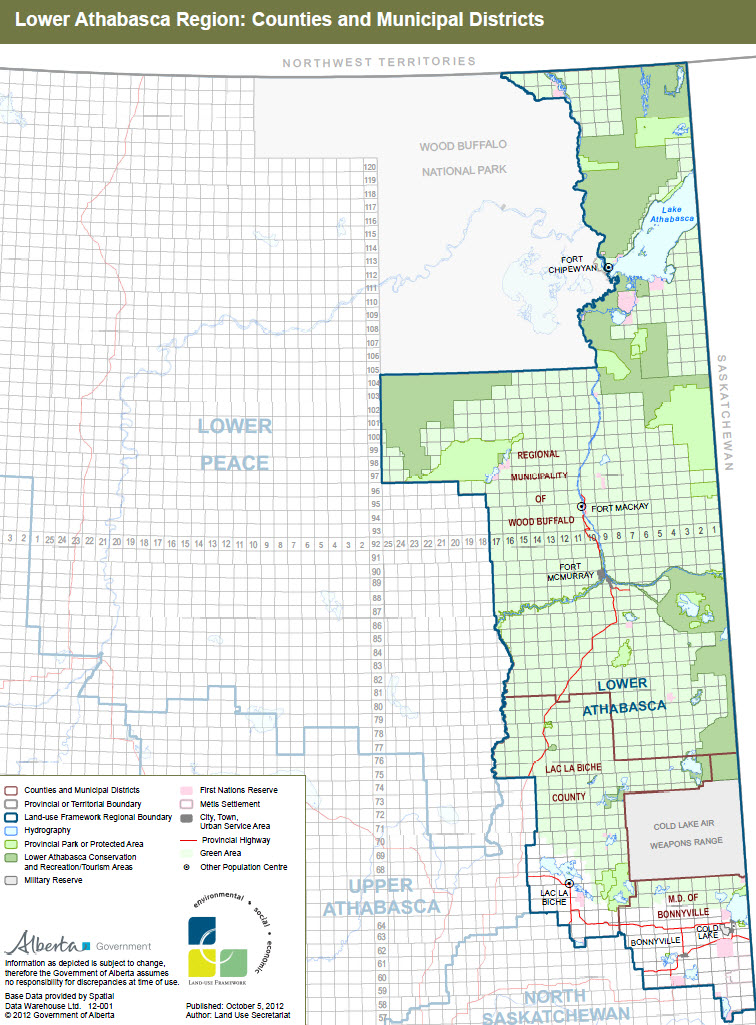Lower Athabasca Regional Plan Consultation
Status: The process to provide feedback on amendments to the Lower Athabasca Regional Plan to incorporate the regulatory details of the Cold Lake and the Bistcho Lake sub-regional plans is now closed.
Opportunities to provide feedback on amendments to the Lower Athabasca Regional Plan to incorporate regulatory details for the Cold Lake and the Bistcho Lake sub-regional plans are now closed. The results are under review. For more information, visit the LARP Amendments page.
Consultation on the Lower Athabasca Regional Plan
Contributions from the Lower Athabasca Regional Advisory Council, First Nations and Métis communities, stakeholders, municipalities and the public informed the development of the  Lower Athabasca Regional Plan (2012).
Lower Athabasca Regional Plan (2012).
Development of Lower Athabasca Regional Plan (LARP) used a phased consultation process:
The government conducted more than 80 public and stakeholder sessions held across the region, in communities located in adjoining Land-use Framework regions and in Edmonton and Calgary. Sessions were held in 15 different cities and communities, including Fort McMurray and Fort Smith, Lac La Biche, Cold Lake and St. Paul. More than 1,000 consultation workbooks and other submissions were received online or in hard copy.
Input on Issues in the Lower Athabasca Planning Region
During May and June 2009, the government held 14 public open houses and 10 stakeholder consultation sessions as part of the first phase of the Lower Athabasca regional planning process. The objectives of the public open houses and stakeholder consultation sessions were:
To support these objectives, the  Profile of the Lower Athabasca Region (2009) provides an overview of key social, economic and environmental factors in the region to be considered in developing a regional plan.
Profile of the Lower Athabasca Region (2009) provides an overview of key social, economic and environmental factors in the region to be considered in developing a regional plan.
About 271 people were involved in the public and stakeholder sessions. Participation ranged from a high of 38 people in Fort McMurray to fewer than 10 in remote communities. Input from the public and stakeholders was gathered and presented in the Phase 1 consultations summary report (above) which informed the Lower Athabasca Regional Advisory Council advice.
Feedback on LARP Regional Advisory Council Advice
This second phase of consultation focused on receiving input and comments on the  Lower Athabasca Regional Advisory Council Advice to the Government of Alberta Regarding a Vision for the Lower Athabasca Region (2010) document by holding a series of open houses, workshops and meetings with the public, stakeholders and municipalities respectively.
Lower Athabasca Regional Advisory Council Advice to the Government of Alberta Regarding a Vision for the Lower Athabasca Region (2010) document by holding a series of open houses, workshops and meetings with the public, stakeholders and municipalities respectively.
Approximately 490 people attended public open houses and 270 stakeholders attended workshops held in numerous locations within the region and in several centres outside of the Lower Athabasca region.
As well, all Albertans were encouraged to review the RAC advice document and provide their feedback by completing either the online or hardcopy versions of the workbook entitled, Working toward the Lower Athabasca Regional Plan - A Workbook to Share Your Views on the Regional Advisory Council’s Advice to the Government of Alberta Regarding a Vision for the Lower Athabasca Region (2010).
In total, 813 completed workbooks were received in the two formats, the majority of which were electronic. There were also 281 partially completed online workbooks and 108 written submissions received.
Three Phase 2 documents (identified above) summarize the results of the public consultation sessions, the stakeholder consultation sessions and feedback received through completed workbooks. This input was essential to development of a draft regional plan.
Feedback on Draft LARP
This third phase of consultation focused on receiving input and comments on the Government of Alberta's  Draft Lower Athabasca Integrated Regional Plan including the strategic plan, implementation plan and proposed Lower Athabasca Integrated Regional Plan Regulations.
Draft Lower Athabasca Integrated Regional Plan including the strategic plan, implementation plan and proposed Lower Athabasca Integrated Regional Plan Regulations.
A series of open houses, workshops and meetings with the public, stakeholders and municipalities were held. Approximately 460 people attended the open houses and 320 stakeholders attended the workshops held in numerous locations within the region and in several centres outside of the region.
As well, all Albertans were encouraged to review the draft plan and provide feedback by completing either the online or hardcopy workbook entitled, Discussion Guide - Draft Lower Athabasca Integrated Regional Plan: A Workbook to Share Your Views with the Government of Alberta.
In total, 329 completed workbooks were received in the two formats, the majority of which were submitted electronically. There were also 119 partially completed online workbooks received.
Three Phase 3 documents (identified above) capture feedback on the draft plan from public consultations, stakeholder consultations and completed workbooks. Feedback contributed to the final Lower Athabasca Regional Plan.

